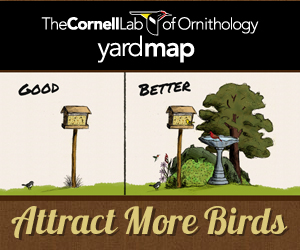Bird conservation: There’s a badge for that
By Krisy Gashler
Could competition, peer pressure and virtual rewards help push people to go green?
Janis Dickinson believes so, and she is using a new social media citizen science project to test the theory.
Dickinson, professor of natural resources and director of citizen science at the Cornell Lab of Ornithology, initiated the development of YardMap, which allows users to add data about any habitat to a Google Maps interface and link those data to bird counts in eBird.org. Participants can outline their site and add details including buildings, grasses, trees, bird feeders and rain barrels, even naming their plants or sharing photos. Although YardMap is still in beta-testing, more than 6,000 sites already have been mapped.
Unlike most citizen science projects, YardMap integrates social features. Users can commit to adopting certain conservation behaviors, such as keeping cats out of the wild or not using pesticides, and these appear as badges for others to see. People can peek at each other’s sites, “like” them, and see how many “followers” each user has. There is also a newsfeed where citizens and researchers can post comments, questions and photos.
The goal of YardMap is to better understand the effects of site-specific habitat features and human practices on birds; to teach users how to create more bird-friendly environments; and to allow citizens to showcase their conservation efforts through a social media platform. Because the software was created at Cornell, researchers can create new tools, options and features to experimentally test ecological and behavioral hypotheses of importance to conservation.
“One of the biggest questions in the study of environmental behavior is how to shift social norms. Recognizing that reputation is important, we are increasingly designing the project to provide opportunities to allow people to display their actions and see what others are doing,” Dickinson said. “That visibility is one thing we think could lead to social contagion, which can nudge environmental norms in more positive directions.”
Dickinson recently returned from a sabbatical at Stanford University, where she pulled together research in social and evolutionary psychology. She learned about homeowners who installed solar panels on the less-effective, shady sides of their houses just to make their investments more conspicuous, and about hotel guests who were more likely to re-use their towels when told that other guests re-used them than when told it was good for the environment.
She and YardMap project leader Rhiannon Crain then worked with Jonathan Schuldt, assistant professor of communication, and Kern Reeve, professor of neurobiology and behavior, to try to understand more about the mechanisms that can lead humans to change their behaviors. The work resulted in a paper that sets a research agenda for online conservation platforms, “Can Evolutionary Design of Social Networks Make It Easier to Be ‘Green’?” published in last September in Trends in Ecology & Evolution.
In it, they concluded: “To be successful, projects will need to provide opportunities for people to develop a social identity and group affiliation, assess their own relative status and the reputations of others, and visualize the collective’s impact on the future.”
Visualizing the collective impact is at the heart of YardMap.
“If everybody reduced their lawn size, had a greater diversity of structure and vegetation types, had berry-producing plants, and if this were done over a larger area of land, say an entire town, this could create one large patch of relatively high-quality habitat,” Dickinson said.
Krisy Gashler is a freelance writer for the College of Agriculture and Life Sciences.
Media Contact
Get Cornell news delivered right to your inbox.
Subscribe